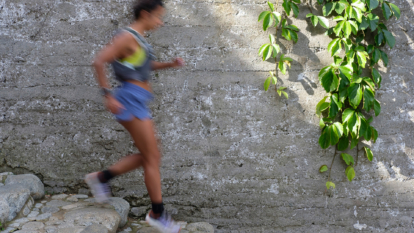Running Led Me Home
After years of trying to fit in with Western trail culture, one runner realizes that what she’s been missing lies in the Colombian mountains of her youth.
All photos by Jr Rodriguez
My knees ache from the steep stone and mud steps; my skin glistens with sweat and humidity that smells like eucalyptus. Behind me, the voices of my mom and my tia merge into one another like the call and response of songbirds above us.
I am in the heart of the universe, the emerald lungs of the earth: the sweet and abundant cloud forest of central Colombia. My plan is to run 50 kilometers (31 miles) from Támesis to Jericó, the small and historic town in the Antioquian mountains where my family was born. Today, I am not just returning to the first home I ever knew; I am running through the doorways of tradition.
I didn’t start trail running until I was in my 20s. But my relationship to the outdoors began long before then. Like most Colombians, my family prioritized time outdoors together across generations of relatives, whether we were hiking, going to the finca or swimming in the creeks. I spent almost all of my time outside.
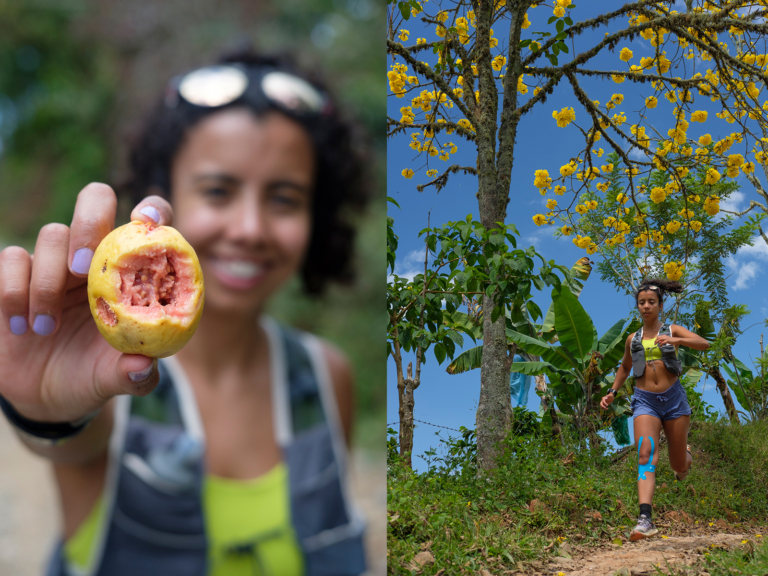
Left: Who needs gels when your route is filled with fruit trees? Chavarriaga shows off Colombia’s bounty.
Right: Most of the trails in Colombia’s cloud forest were originally built for farmers, who live in the mountains, as a way to access town. It just so happens they make for pretty great running, too.
When I was 7 years old, my family moved to Michigan in pursuit of the American dream. I no longer recognized the trees. I no longer spoke the language. Even though I had grown up with my feet in the mud and my eyes in the canopy, I felt like I no longer belonged outdoors. Sure, I knew about walking. But here, forests were neatly designated and required a car to get to. Concepts like trailheads, entrance fees and hiking gear got lost in translation.
As I got older, I worked hard to refamiliarize myself with and regain access to nature—something I’d formerly assumed was a universal right. I worked at a gear shop in Michigan, took courses on how to be “outdoorsy” and ultimately left my family behind to go to school in Wyoming, where I soon found my way to the Tetons. Here, in my early 20s, I had playgrounds of granite at my fingertips, but still felt unwelcome.
Most runners, skiers and climbers that I met in the Mountain West were quiet and stoic; doing these sports was a solitary and serious activity. Most people either ran alone or for speed, kept their favorite stashes secret, and purposefully excluded beginners and those who were new to the area.
At every turn, I found myself confronting perspectives that went against the way I was raised. In Colombia, people invite everyone they meet to go outside with them; we’re constantly talking, singing and laughing our way up the trail. No one cares about speed because we’re too busy stopping for wildflowers, berries and river dips. It took me years to figure out that these approaches aren’t right or wrong. I don’t know better or worse than anyone else; I just know different.
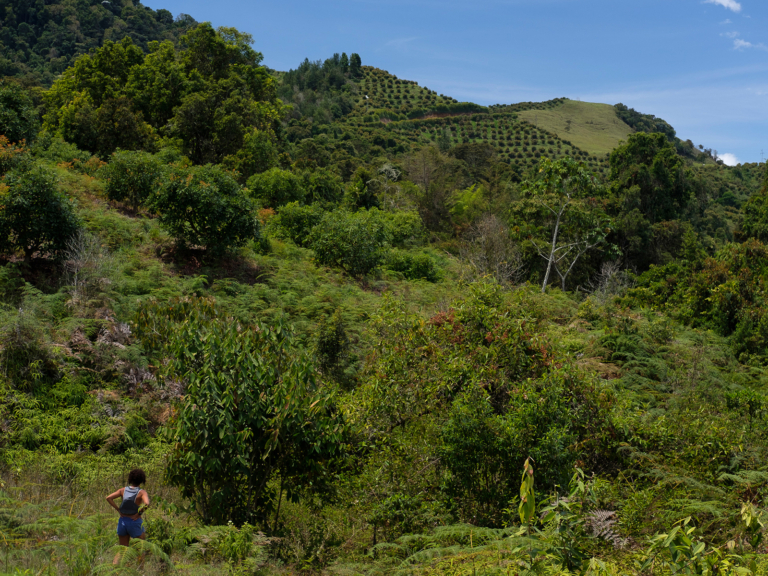
In every long run, there comes a point where you begin to question your decisions. As the day heats up and the mosquitos come out to feast, Chavarriaga finds hers.
Back when I lived in Colombia, there was one particular hike called Las Nubes (The Clouds) that only the grown-ups and older cousins were allowed to do. They would leave by 5:00 a.m., so I would never catch them. But they would always bring back stories. For me, this trail represented a mystical dream.
Now, I’m the one traveling to faraway lands and have the honor of bringing stories back to share. In 2023, when I made plans to spend part of the summer visiting family in Colombia, I couldn’t imagine a better way to celebrate than by bringing my running shoes (and a friend) home with me and taking on a big route in the Las Nubes area—the very same forests I dreamt of as a kid. Even better, my mother and aunt asked if they could join us for the beginning of the run, which involved a 3:00 a.m. wake up and a long drive on a bumpy road.
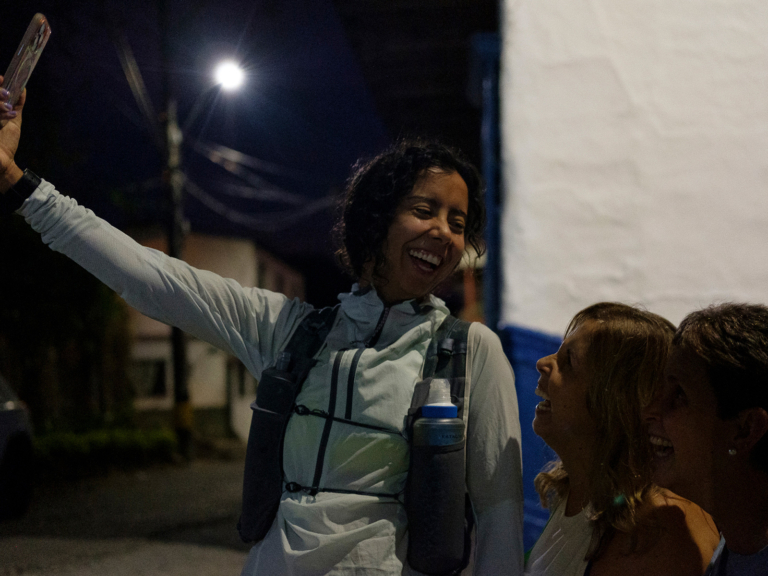
Fact: Ambitious trail runs are more fun and more rewarding when you can share them with your community. Chavarriaga poses for a pre-run selfie with her mother and aunt, who joined for the first summit of the day.
An hour and a half later, we pull into the village of Támesis, where we will begin our run. The only people stirring are those still awake from the night before, playing a game with coins and bottles outside of the cathedral. We begin by climbing above the city and pause to watch deep hues of lavender and salmon paint the clouds. Usually when I’m exploring trails on other parts of the globe, I stop to preserve these moments through my words and photos so I can share them with family later on. But this time, my loved ones are right here with me. I don’t have to wait. I stand quietly, relishing this rare moment of my two worlds coming together.
After a few minutes, we split up for the journey home—my mother and aunt back to the car, my mountain partner and I onward through the forest. The trail tells a story of precolonial times. Thousands of years ago, over 48 different Indigenous groups paved the way with stones as they traveled over the mountains. Today, this path is surrounded by a spiderweb of coffee farms and trails that exist primarily for cosechadores and their mules to pick coffee beans and bring them to the nearest town.
Our route connects variable pieces of these old “roads” and trails, which require some creativity to link. One minute we are traveling through the cool and humid cloud forest and the next we emerge onto a local’s coffee farm, their dogs escorting us through the grassy hillsides.
Because these trails were built for those living in the mountains to access towns, they climb sharply up and down rather than traversing. We ascend high above a village before descending all the way back down to the next one, and then begin climbing anew. After several hours, the coolness of dawn wears off and exhaustion begins to set in. I dip in cold streams and rivers and dunk my head beneath waterfalls at every chance I can. Mosquitoes, almost invisible but inescapable, leave large welts on my skin. Sometimes the paths are clear and distinguished. Other times they look more like dry irrigation ditches filled with overgrown ferns and banana spiders. Still, we hardly go a few miles without bumping into other people.
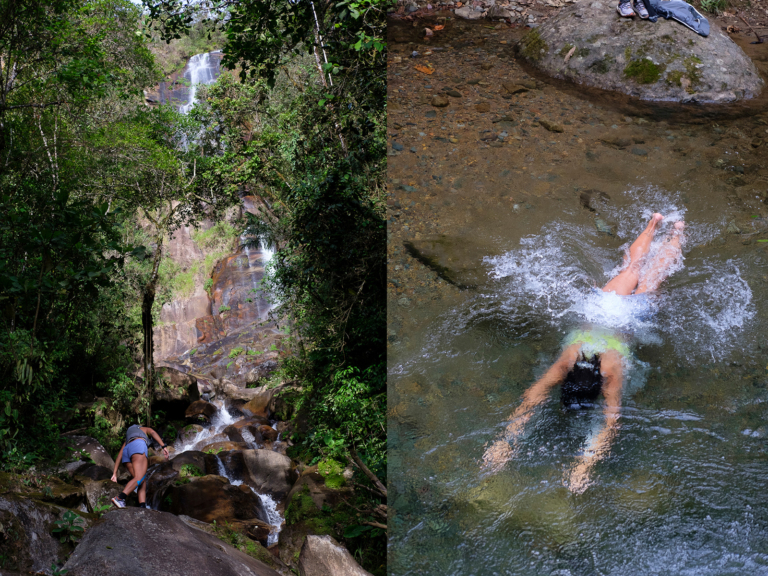
Left: Waterfalls are always worthy of a detour—especially when it’s 85 degrees and humid.
Right: Chavarriaga pauses for an all-important dip in one of the many streams along the route from Támesis to Jericó.
“¿Para dónde van?” the campesinos on the mountain ask us. My response is not a straightforward one. It involves enthusiastic hand waving, squinting, pointing and three childhood stories. Each time I finish, I expect astonishment or praise for our ambitious plan. Instead, they respond by telling us about the times they did the same route just to go to the river, and then share knowledge with me that I would never find on a map: paths through different neighbors’ farms, shortcuts, places to dip in the river or find the best salpicón—a concoction of tropical fruits and condensed milk served cold, often at roadside stands in small towns. My preparation seems rudimentary compared to their lifetimes of experience. My running shorts and hydration vest—gear that I worked for years to understand and afford—now seem inferior to their worn-out jeans and sombreros. Today, they are the experts.
In the Mountain West, experience often begins with courses, certificates and the mentorship of those who accept you. In Colombia, it begins simply with wonder and exploration. Here, the true experts aren’t those who know the most difficult route, but those who know the simplest one. They’re the people who take pride in extending a hand, sharing tips and stories with anyone they meet on the trail.
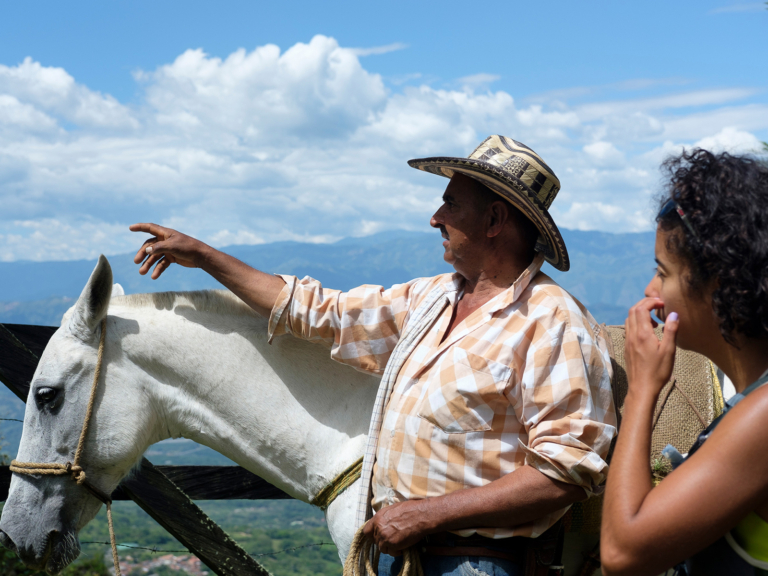
Some trail beta just can’t be gleaned through GPX files. Midway between Támesis and Jericó, Chavarriaga stops to get directions from a local farmer.
Time slows down in Colombia. No one is ever in a rush. Running here is like this, too. Our aid stations are not temporary tents. They’re permanent: la casa de la esquina where people await you with cold water and cheers, the estadero serving fruit and drinks on the side of the road between two towns. The food we eat on the trail is the same food we share across tables—recipes that our ancestors passed onto us because they are rooted in the science of having a deep relationship with the land. It’s food that tastes exactly like where you are. We wrap our tamales tightly in plantain leaves, ready for the journey ahead. We run with crystallized guava, fresh fruits and electrolyte drinks made of sugarcane. Instead of slurping caffeinated gels, we stop for coffee, which is served hot, so that we have plenty of time to sit and catch up while we wait for it to cool.
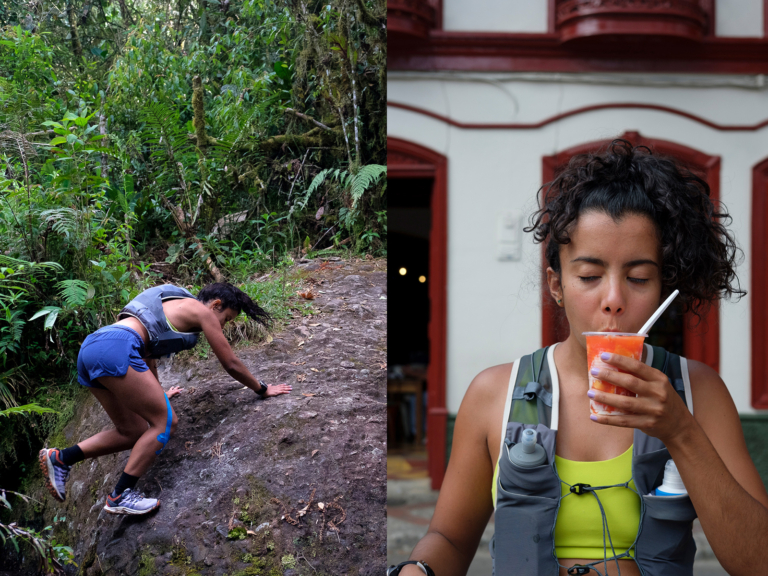
Left: Sometimes, trail running in Colombia’s cloud forest involves very little trail and very little running.
Right: There’s nothing quite like a cold treat after a long, hot run. Salpicón, a concoction of fruit and condensed milk, makes a pretty good one.
As an immigrant, I have spent a large part of my life not fitting into boxes. Some days the expansiveness is freeing, and other days it’s isolating. Immigrating at such a young age made it difficult for me to develop a relationship with Colombia—and with the mountains—that felt like my own.
But when I run on Colombia’s dirt-packed roads and overgrown trails, I feel like I am creating space for my whole self, weaving together sport, heritage and tradition. On these home trails, I feel supported even by complete strangers. Isolation disintegrates. Mountain days become a community effort, and joy becomes collective. I am reminded that trail running doesn’t need to be difficult to be worthwhile. It can feel easy and natural, like a smile spreading across someone’s face.
Our journey culminates at dusk with a salpicón in the Jericó plaza. My aunt and mom, along with many of the town’s other residents, are anxiously waiting for us to arrive and tell them stories of their lands. Their faces light up with joy each time our conversations spark a memory of their youth spent outdoors. Together, we marvel at the beautiful and difficult corners of our homeland that people rarely see—“secret” places and experiences that feel even more special because we share them.
